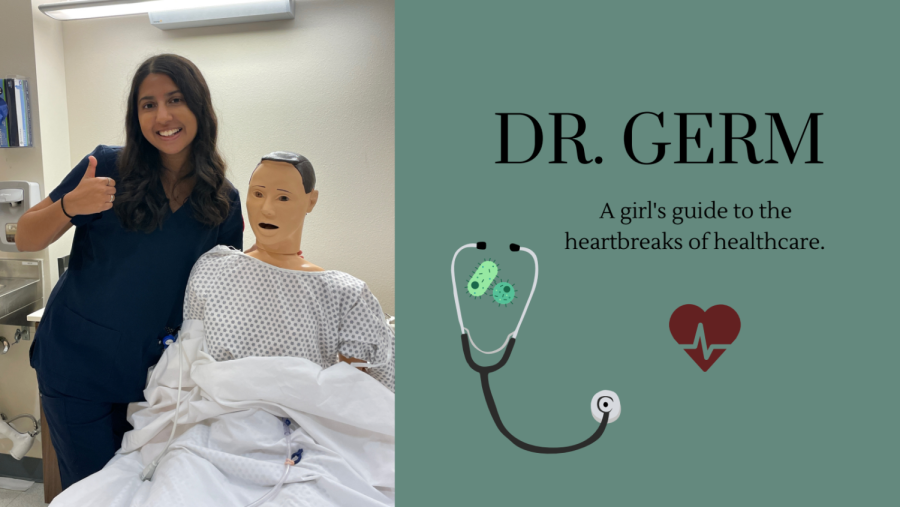Dr. Germ: are we losing more doctors than patients?
In this weekly blog, staff reporter Shannon Christian writes about the myths of healthcare and how it impacts students.
The current structure of health-science education within the United States throws potential medical professionals into the deep end with a do not resuscitate order; it deters future students from pursuing the field. This consequently minimizes the pool of future care providers.
As a student who has aspired to join the medical field since I was in elementary school, I’ve noticed that over the years, the people who have shared this interest with me have decreased significantly. The most notable decline in health-science-oriented peers I’ve witnessed was freshman year of high school. Freshmen in Frisco are offered an elective course that is not specific for a graduation requirement, so many students choose the class that they deem most interesting. This has not been the case recently. Many high-achieving freshmen find themselves choosing the course that increases their GPA the most. GPA-boosting courses include AP courses such as AP Physics or AP Computer Science, which are available to freshmen.
The health-science elective available to freshmen, Medical Terminology, however is weighted as an on-level course (a 5.0 scale), steering away many freshmen who wish to advance their GPA and grades as much as possible during their first year of high school. Then, when they do not participate in Medical Terminology, later in their high school careers, students are unable to take successive health-science courses such as Anatomy and Physiology, or CTE classes such as Pathophysiology and Medical Microbiology as Medical Terminology are the courses’ prerequisite.
These health science courses that I previously listed are all weighted as on-level courses with a maximum of 5.0 to be factored into a student’s GPA. The idea that these elective courses are considered on-level, even though they entail rigorous work and are content-heavy, discourage students from taking part in these courses as they believe they can better their GPA by taking another AP elective (6.0 scale) instead. Since Frisco ISD is well known for our competitiveness, for most students, having the highest GPA possible is of utmost importance, resulting in the fact that they would take AP courses they are uninterested in for the sole purpose of raising that GPA. Thus, the pool of students who not only want to participate in health science courses, but are eligible to, has become smaller each year.
Research conducted by the National Library of Medicine indicated that 97 percent of students who participated in health-science courses in high school continued a health education after high school, 70 percent doing so by attending a four-year university. If more students are able to take courses related to their field of interest, such as health-science, they may be able to be more successful in continuing their education in college as well as following their career path.
While students can join health-science classes when they start university, this can place them at a disadvantage as they haven’t been participating in medical-oriented courses or practices, which could potentially detract from their desire to pursue the field.
Furthermore, when looking past high school and examining the culture of medicine present within universities, joining a pre-medicine program can seem very daunting. Starting an education in medicine is an enormous commitment, as schooling to obtain a Doctorate in Medicine can take 12 years after high school. Pre-medicine courses are also very challenging in universities, many students struggling or failing, and thus having lower chances of continuing their health education and going to medical school, or another graduate program in healthcare. In addition to the difficulty of getting into medical graduate programs, the idea of spending 4-8 years within the program with only a base-level salary and constant rigor within rotations and testing for certifications further pushes students to find alternative careers or areas of study.
The issue present in the United States is not that people are not interested in medicine. The field will be ever present and its vitality will not fade; everyone in the world gets sick, and there will be people who pursue jobs that are highest in demand. The issue instead lies within how students are trained and treated within areas of health-science that deters them from continuing education or even from pursuing the field.
In Frisco ISD just credit can be given to the field and those who wish to pursue it by increasing the weight of these health-science courses regarding grade calculations thus the significance of health-science can be emphasized within the lives of students as well. For universities and graduate programs training students to enter the world of medicine, the current requirements and assessments of students should be reassessed, and rectified in a way that prioritizes the student, in that the field can grow with more competent, interested professionals.
Currently, the United States is in a shortage of nurses and medical professionals. While this can be linked to the wages that nurses earn, regarding other professions, it seems that the facilities that are meant to train more students, are denying future professionals, causing the crisis to become chronic.

